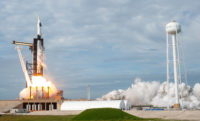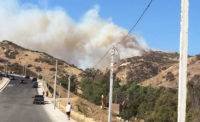Risks Revisited
What is the Chance a Solar Storm Could Knock Out The Power Grid?
Researchers fine-tune estimates of a strong punch that could put out our lights

An image of a coronal mass ejection on the Sun that occurred from June 17-18, 2015. NASA's Solar Dynamics Observatory caught the action in the 304 Angstrom wavelength of extreme ultraviolet light. While some of the plasma falls back into the Sun, a large cloud of particles heading into space. Credit: NASA/SDO
Having wiped out the dinosaurs, asteroids also have the potential to knock all human life into the past tense. The sun, on the other hand, is never as ominous, sending friendly reminder bulletins that attest to its power when it sheds energy, particles and plasma. Only recently did I start to take account of scientific estimates of the probability of a solar event that could put out the lights, literally, in a small area of our electricity-dependent civilization.
Astrophysicists who study the sun have said there is a 12% chance that a solar event equal in power to the largest one known could hit in any given decade. That’s a very high chance for an event that could cause a natural disaster that could fry parts of the electrical infrastructure of a major city or regions—which means we need to devote more resources to system-wide resilience.
Unlike solar flares, where electrical energy traveling at the speed of light bursts from the Sun's corona but doesn't travel very far, a coronal mass ejection has more potential for planetary havoc.
The biggest recorded solar storm to penetrate the Earth’s magnetic field, the 1859 Carrington event, as it is known, struck telegraph systems in the U.S. and Europe. If it occurred today, such an event could knock out power and communications in some places for days, months or, by some estimates, years. Unlike solar flares, when electrical energy traveling at the speed of light bursts from the sun’s corona but doesn’t travel very far, the Carrington event was triggered by a comparatively slower-moving coronal mass ejection, which has the potential for more planetary havoc. Like a solar flare, a CME begins with the sun’s magnetic field twitching, which releases massive amounts of energy. When a CME bursts away from the sun, it sends outward plasma waves with charged particles. With enough power and at the right angle, the plasma can penetrate the Earth’s protective magnetic field.
That’s when the trouble starts. Scientists have been trying to determine how much harm a Carrington-level event could inflict. Higher latitudes are at greater risk. One example is the Quebec blackout of March 1989, when a CME plasma cloud 35 times the size of the Earth burst from the sun, causing powerful electrical currents 100 kilometers above parts of the Earth’s surface and in the ground. The solar energy also induced current and wild power swings that tripped and shut down capacitors. Montreal’s Metro and airport closed. According to author David Whitehouse’s book, “The Sun: A Biography,” New York state almost lost power.
Eventually, the sun itself will burn out in a few billion years. By then, other universes will have outlived our own. But a 12% Carrington-level event probability over a decade? That’s high. Where did that percentage come from?
Peter Riley, a scholar of predictive science, published that percentage in a 2012 journal article in which he also noted that the probability heavily depended on how he defined an extreme event. Jeffrey J. Love, a researcher at the U.S. Geological Survey in Denver, also considered the 10-year-occurrence probabilities of geomagnetic storms and various other natural events. For comparison purposes, a magnitude-8 or higher earthquake, such as the 1906 San Francisco earthquake, has a 4% chance of occurring over any three-decade period.
Riley and Love, writing as a team in a recent issue of the Space Weather Journal, conceded that the uncertainties in their initial CME studies were “huge.” So, in a new research project, they set out to expand on their previous efforts by taking into account different ways of modeling the data and the usual problem of definitions. They found that both power law and “lognormal” distributions—that is, statistical methods for determining functional relationships between two quantities—fit best for their data. But the results “varied substantially,” depending on which data sets, which intervals and which distributions they used to make the estimates.
Assuming that power-law distributions, which commonly fit many types of natural occurrences and have long statistical tails, were most appropriate, Riley and Love now estimate there is a 10% chance of a Carrington-level event over the next decade. On the other hand, the power-law distribution is likely an upper limit to the behavior of the tail, and the sun is now in a period of low solar activity, they write. But I still consider Riley and Love’s 10% alarmingly high for a low-frequency, high-impact event.
So, that’s where it stands. Just as we prepare for hurricanes and earthquakes, we must takes steps to protect our infrastructure, especially in big population centers. Fortunately, since we inhabit very little of this world, the risk is less than it would be. The question is whether our society has the collective will to prepare.





